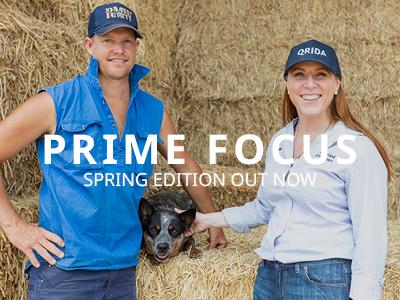
Get your farm ready for a hot and wet QLD summer
Queensland producers are encouraged to prepare for a hot and wet summer, with climate scientists forecasting extreme heat and warm ocean temperatures that could lead to cyclones.
QRIDA Disasters and Drought Manager Sheree Finney unpacks what the Bureau of Meteorology’s first long-range
forecast means for your farm’s disaster preparedness.
“Firstly, it’s important to note that despite the best climate scientists, long-range forecasts can and do change as weather patterns are constantly evolving,” Sheree said.
“So, while primary producers should heed the warning of tropical cyclones, it’s important to get ready for all disasters including bushfires, storms and floods.”
With experience over several years leading QRIDA’s disaster recovery assistance, Sheree has gathered the tried-and-true disaster preparedness tips below that have helped mitigate damage on farms.
“If your farm is impacted by an extreme weather event, and once it is safe to do so, take photos of the damage, even if you think it is minor, as this will be required for any QRIDA recovery financial assistance applications.
“I also encourage you to upload these images to the Department of Primary Industries’ voluntary Disaster Impact Survey and complete the survey questions as this helps the government assess the extent of the damage for the activation of recovery assistance.”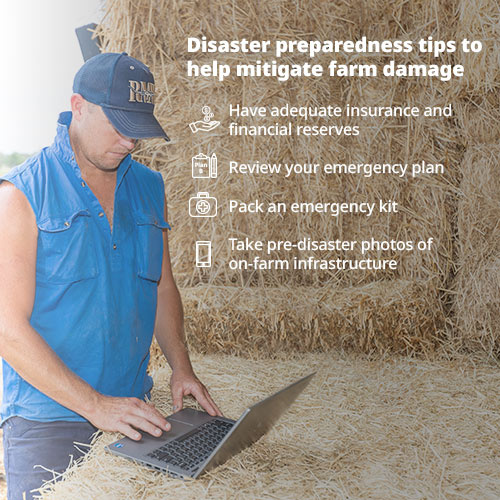
While QRIDA reminds Queenslanders to get prepared for the upcoming disaster season, Sheree said QRIDA also continues to focus on helping primary producers recover from cyclones and flooding earlier this year.
“If your operation was impacted by these events, there’s still plenty of time to apply for QRIDA disaster recovery grants and loans,” Sheree said.
“The forecast for the months ahead means the 2025/26 disaster season may be similar to the last, but whether summer brings cyclones, bushfires, storms or floods, remember Queensland - we’ve done it before, and we can do it again.”
For more information about QRIDA's disaster financial assistance and how you can prepare your QLD primary production operation for disaster, visit the Disaster Preparedness webpage.
Supporting farmers in first two months as QRIDA’s CEO
It’s been a busy couple of months since I took over as QRIDA’s new Chief Executive Officer. It has been fantastic to have the opportunity to be out supporting various events engaging with our many clients, industry, professional and government allies.
These events included the Young Beef Producer’s Forum in Roma, the Queensland Farmers’ Federation’s National Agriculture Day Breakfast, the Rural Regional and Remote Women’s Luncheon at Parliament House, and the Queensland Rural Press Club’s International Rural Women’s Day Luncheon.
With my previous experience of three years as QRIDA’s Chief Lending Officer, and on the back of QRIDA’s strong foundation of over 30 years as a government financial assistance administrator, I have set out in my new role to help QRIDA do even more for primary producers and the rural and regional Queensland communities they live in.
I’ve also been working closely with our Department of Natural Resources and Mines, Manufacturing and Regional and Rural Development, and QRIDA's Board to review our strategic direction with a focus on making it easier for producers to get started and grow their operations, and to expand QRIDA’s support to the agricultural supply chain.
Behind the scenes, we’ve been using technology to help streamline QRIDA’s loan and grant application and assessment
processes so primary producers, small businesses and non-profit organisations can get the financial assistance they need easier and quicker than ever before.
These changes are coming just in time for the upcoming disaster season so that we can better support Queensland communities recover from future disasters, as well as for those who are still getting back on their feet after cyclone and
flooding events earlier this year.
As QRIDA prepares to support primary producers recover from potential disasters over summer, I want to echo the reminders on the front page of this edition to encourage you to also prepare your farm business for extreme weather events in the months ahead.
Lastly, I want to sincerely wish you a safe and happy festive period and thank you for your continued support and trust in QRIDA throughout 2025.
I look forward to travelling across regional Queensland and speaking with as many primary producers as possible in the year to come as part of my commitment as QRIDA’s new Chief Executive Officer to lead the team in doing even more for Queensland’s agricultural industry.
Brooke Irwin
QRIDA Chief Executive Officer
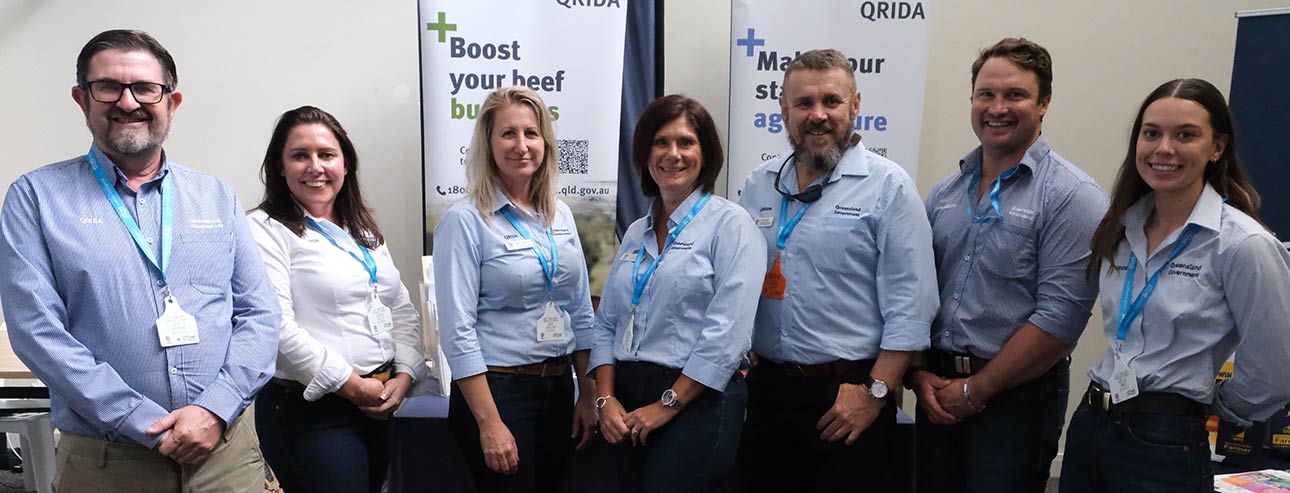
Brooke (centre) and the team representing QRIDA as Silver Partners of the Young Beef Producer's Forum in Roma.
38-year family farming legacy continues with QRIDA First Start Loan
For almost 40 years, the Eggerling family has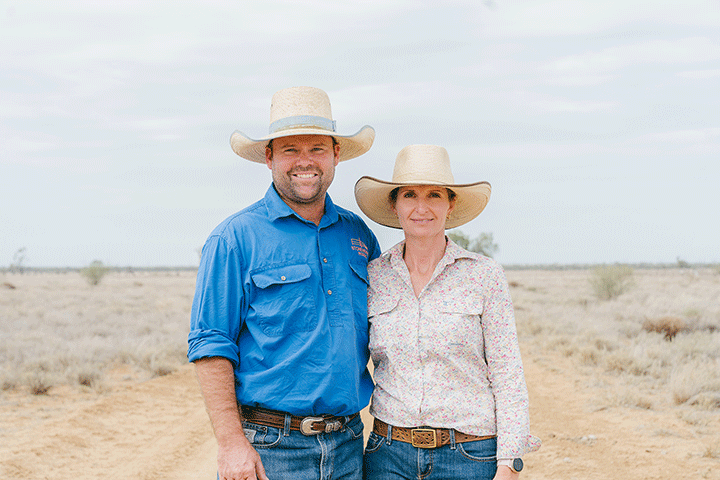 cultivated a family farming legacy, weathering Queensland's challenging conditions and nurturing their sheep farming business, ‘Wynn Downs’, just outside of Longreach.
cultivated a family farming legacy, weathering Queensland's challenging conditions and nurturing their sheep farming business, ‘Wynn Downs’, just outside of Longreach.
With the help of a QRIDA First Start Loan, that family farming legacy will continue with Martin and Beck Eggerling.
When the time came for Martin’s parents to pass on the baton of their sheep enterprise, he and his wife, Beck, embraced the opportunity with open arms to carry on the family operation.
“We purchased ‘Wynn Downs’ from Martin’s parents; they were here for 38 years prior to that. The opportunity
came up and we grabbed it with both hands,” reflects Beck.
Navigating succession can be a daunting task for many farming families, but Martin says the assistance of QRIDA's First Start Loan enabled them to accelerate their succession plans and turn their focus to creating a future for their children.
We’ve got three children of our own, and that’s something we’re certainly looking to do is set them up for their future as well,” he says.
Local Regional Area Manager for the Central Highlands and West, Brad Whittington first met the Eggerling’s at the Isisford Sheep and Wool Show and was able to share information with them about how the First Start Loan could be used as a financial stepping stone to assist with family succession.
“The QRIDA First Start Loan is a very good product to get young people into the primary production industry.
“I helped Beck and Marty understand how the livestock schedules and cashflows marry up with what they're predicting and how they work.”
Beck says Brad's support was invaluable throughout their application journey.
“The help we had from Brad throughout the whole process was second to none, he was so approachable. When it came
to the application there were no silly questions, he made it all make sense, and he was wonderful.
We advise people if they want to take that step, sit down with your Regional Area Manager and ask the questions,” she says.
Brad encourages young producers to start the conversations and seek information on the financial support available such as First Start Loans.
“Doesn’t matter how small the question seems to you, ask the question and get an idea of where you can go with QRIDA’s products like our First Start Loans,” he says.
QRIDA's First Start Loan which offers up to $2 million in support, stands as a support beam for the next generation of producers, providing them with the financial stepping stone they need to make a start in agriculture.
Read or watch the Eggerling's story here.
You are not alone: A timely reminder mental health support is available
It’s normal to experience mental health challenges during tough times, but please remember – you are not alone.
Queensland’s upcoming disaster season offers a timely reminder that there are a range of free and confidential mental health support services available to help primary producers get through the distinct challenges that come with life on
the land.
While QRIDA is a financial assistance administrator, the mental wellbeing of all our clients is of great importance to us.
Our team is also part of your community and industry, and we encourage all primary producers to get the help they need so they can be their best on and off the farm.
For a directory of mental health support services for primary producers, please visit our mental health resources.
Please note: If you or someone you know is experiencing a mental health emergency, call triple zero (000).

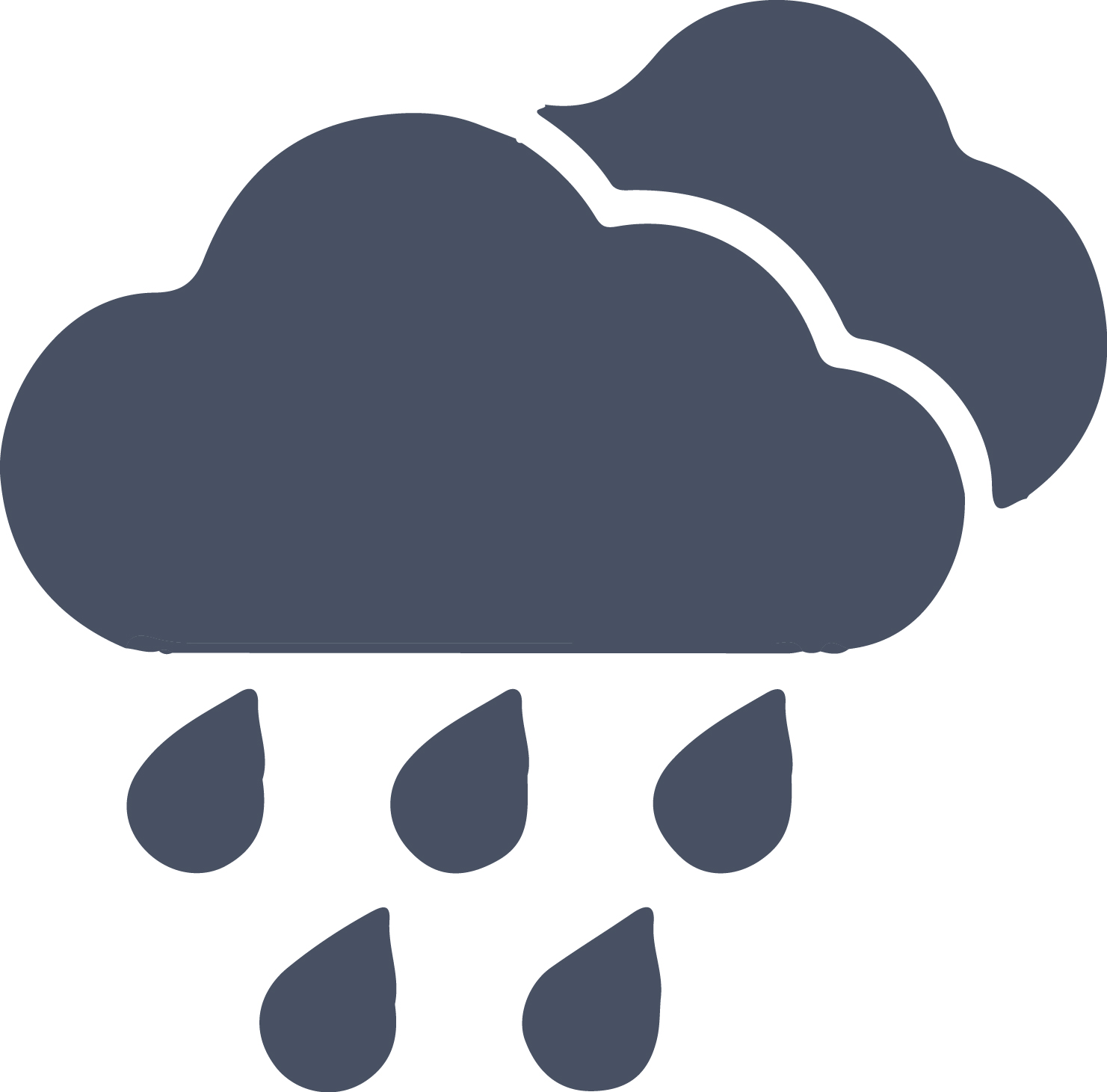 Keep track of your rainfall
Keep track of your rainfall
Record the rainfall on your property with our online Rainfall Chart.
Visit the Rainfall Chart webpage to download your copy.
The results are in! 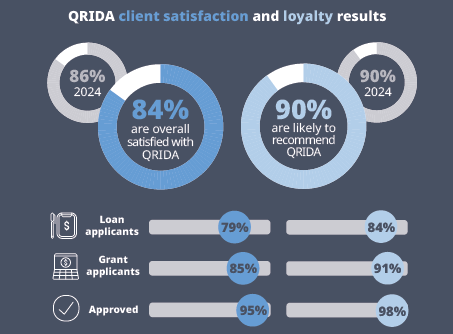
QRIDA is proud to share the pleasing results of our 2025 Client Satisfaction Survey.
The telephone survey was undertaken by an independent research firm with a random sample of 250 primary producer, small business and non-profit organisation clients who had applied for QRIDA's First Start Loan, Sustainability Loan, Disaster Loan, Drought Loan, or Disaster or Drought Grant programs within the past 12 months.
QRIDA welcomes feedback from our clients and stakeholders and uses the valuable information gained from this research to improve our programs and service delivery.
Our team in regional Queensland, helping yours
QRIDA has a network of Regional Area Managers (RAMs) based throughout Queensland who can provide you with the latest local knowledge and expertise on our programs and services.
We've got Queensland covered with offices based in Brisbane, Bundaberg, Emerald (with regular visits to Longreach), Hughenden (with an office in Cloncurry), Innisfail, Kingaroy, Mackay, Rockhampton, Roma, Toowoomba and Townsville.
In each newsletter we feature an update from three of our RAMs. To find details of your local RAM, contact us on 1800 623 946 or visit the Your Region webpage where you can search by region or postcode.
Bradley Whittington, Central Highlands & West 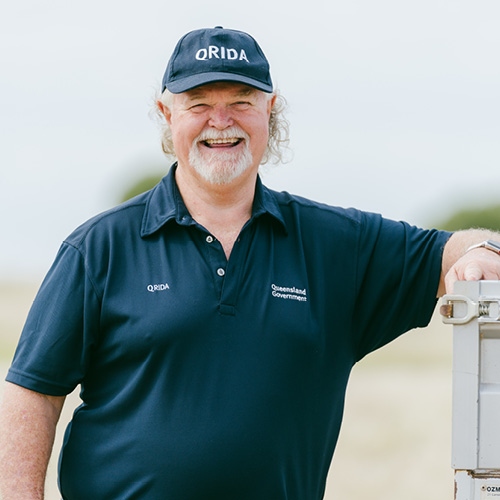
We’re quickly approaching the disaster season so now is the time to be proactive with your disaster preparedness activities.
Start by reducing potential hazards around your premises. Secure loose items, clear debris, and carry out necessary maintenance on buildings, equipment, and infrastructure to prevent damage during severe weather.
Review your insurance policies to ensure they are up to date and fit for purpose. Make sure you fully understand what is
covered to avoid surprises during claims.
Develop an emergency and evacuation plan tailored to your needs. Store an emergency kit in an easily accessible location, including essentials such as first aid supplies, torches, water, and non-perishable food. Identify alternative power, access, and communication options to maintain business continuity.
Know who your local QRIDA Regional Area Manager is, as they can provide support before and after disaster events.
For further disaster preparation tips and resources, visit QRIDA's disaster preparedness webpage.
Lastly, stay connected by subscribing to QRIDA’s disaster updates newsletter so you know the latest disaster information as it becomes available.
John Metelli, Capricornia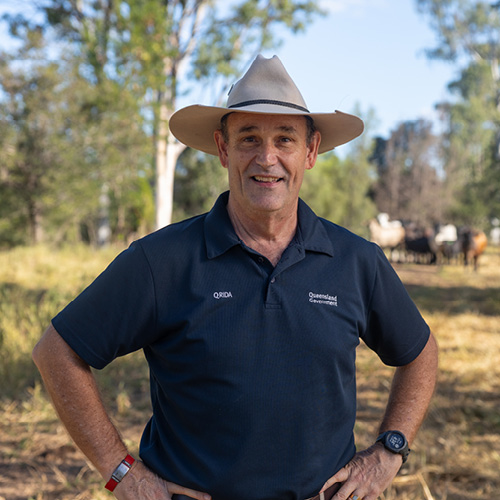
Central Queensland’s bull sale season is coming to a cracking end, with prices and clearance rates well above those in 2024.
The firm beef market is characterised by favourable economic and expected seasonal conditions. I’ve seen this growing optimism first hand in some of the producers I’ve spoken with in the selling ring about how QRIDA’s loans could help them achieve their breeding and wider primary production goals.
Whether you’re in the beef industry, cropping, horticulture or even commercial fishing, I’d love to chat with you about how QRIDA’s financial assistance could help your operation as we near the halfway point of the financial year.
As summer approaches, so too does disaster season. While our region hasn’t experienced a major disaster since Tropical Cyclone Marcia in 2015, let’s not get complacent – disasters can happen anywhere, anytime.
I encourage you to follow the disaster preparedness tips on the front page of this newsletter and if you have any further questions get in touch with me.
Mark Barrett, Wide Bay & Fraser Coast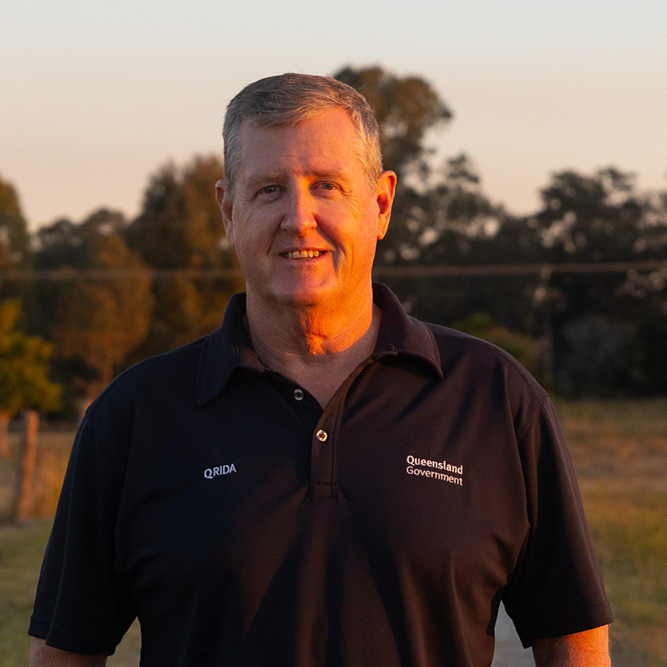
This year has flown by - it’s hard to believe December is almost here. Back in mid-September, I had the opportunity to attend Bundaberg’s annual AgroTrend event, which once again showcased the innovation and resilience of Queensland’s
agricultural industry.
From the latest applications of AI in horticulture to managing varroa mite and improving farm safety, the event offered valuable insights across a range of topics.
It was a great chance to reconnect with local producers, service providers and researchers, and to hear first hand what’s
driving the region. Events like this are a vital way for QRIDA to stay engaged with the agricultural community and ensure
our programs continue to meet industry needs.
As we move into summer and the end of another busy year, it’s a timely reminder for producers to stay prepared for the season ahead.
Visit QRIDA’s disaster preparedness webpage for tips and resources to help safeguard your business before, during and after severe weather events. If you are impacted by a disaster, remember to monitor the QRIDA website for updates on available assistance and support programs.
Missed out on a previous copy of Prime Focus? Read past editions here:
2025
Winter 2025 (PDF 1.1MB) | Autumn 2025 (PDF 1,032KB) | Summer 2025 (PDF 1,582KB)
2024
Spring 2024 (PDF 1,849KB) | Winter 2024 (PDF 1,681KB) | Autumn 2024 (PDF 1,650 KB) | Summer 2024 (PDF 1,582KB)
2023
Spring 2023 (PDF 1,906KB) | Winter 2023 (PDF 1,386KB) | Autumn 2023 (PDF 1,406KB) | Summer 2023 (PDF 654KB)
2022
Spring 2022 (PDF 618KB) | Winter 2022 (PDF 708 KB) | Autumn 2022 (PDF 577 KB) | Summer 2022 (PDF 537 KB)
2021
Spring 2021 (PDF 655 KB) | Winter 2021 (PDF 626KB) | Autumn 2021 (PDF 602KB) |
2020
November 2020 (PDF 665KB) | May 2020 (PDF 561KB)
2019
December 2019 (PDF, 602KB) | July 2019 (PDF, 623KB) | March 2019 (PDF, 619KB)
